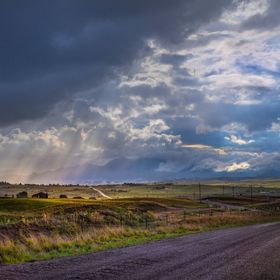

lindaekstrum
FollowThe grasslands of southern Arizona is a favorite stop over for migrating birds and home to cattle grazing on the rolling hills. This tree, a Cottonwood is Janu...
Read more
The grasslands of southern Arizona is a favorite stop over for migrating birds and home to cattle grazing on the rolling hills. This tree, a Cottonwood is January bare and reflects in a pool of winter rain.
Read less
Read less
Views
217
Likes
Top Ranks
Categories
Same photographer See allBehind The Lens
Discover more photos See all
Behind The Lens
Location
Most people associate the desert with Arizona but, truly, it is a diverse state with forests in the northern part and grasslands in the southeast. In fact, the swath of grassland is so extensive it covers two counties. I took this photo in the San Rafael Valley which is home to the Vaca Ranch and the Nature Conservancy and is located close to the Mexican border in Santa Cruz county. For a few months each summer, the monsoon rains turns this prairie a lush green. By September, however, the color begins to fade and the landscape becomes a subtle shades of yellow and browns. It is a monotone delight. I took this photo in January after the rain and when this tree was bare.Time
I took this photo mid-day. Why, you might ask knowing the best hours are at the beginning and end of the day. True, unless you are shooting with a dedicated infrared camera. Mid-day then becomes the friend of the infrared photographer as this is when the richness of the contrast of light and dark are the most dramatic.Lighting
Mid-day lighting probably 12:00-2:00 PM, aka, harsh daylight without clouds to soften the scene.Equipment
I use a Nikon D-100 that has been converted to infrared. My tripod is made by Benro and I use a Really Right Stuff B-40 Ball head. I don't use filters with my infrared camera and I don't want the natural effects to be filtered.Inspiration
Picture a wide bow-shaped valley with distant mountain on all sides and rolling hills that are dotted with scrub oak trees. This spot in the road is marshy with a small amount of standing water; enough to allow this lone ash to flourish with its reflected companion. It is the only tree of its kind in the entire valley. As an introvert, I am drawn to companionable solitude.Editing
There are a number of filter options when converting a camera to infrared--some shift to blues and yellows whereas my sensor shifts sepia tones. When processing I can bump up red and yellow in Hue/Saturation but the other colors have little affect. For this photo, I created a triptych of olive green, purple and aqua blue. In order to achieve these colors I had to apply filters in Photoshop.In my camera bag
I normally shoot with a Sony a7rII. My Sony lenses include: FE 2.8, 20mm, FE 4, 24-70, FE 4, 24-240. I keep these lenses available (using a meta-bones Nikon adapter) for a vintage Tamron F 2.5, 90 mm, Nikon 2.8, 10-24mm, and a Nikon 1.8, 50 mm.Feedback
The subject of the Lone Tree is one that strongly evokes, connecting with some part of the human psyche that understands loneliness or solitude. Sometimes the lone tree speaks of braving the elements alone or is a symbol of persistence. I have noticed that lone tree photos benefit from some added element such as, in my photo, a reflection but others take advantage of weather, perhaps fog or dramatic clouds. The happy advantage of taking this singular image is that usually one is far removed from the crowd. I recommend becoming your own lone figure when taking a image that surrounds itself with breathing space. Don't forget to breathe.











































